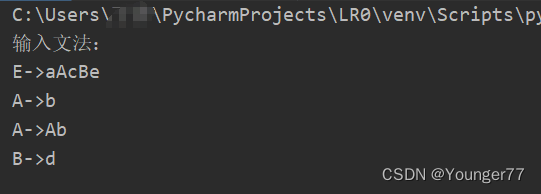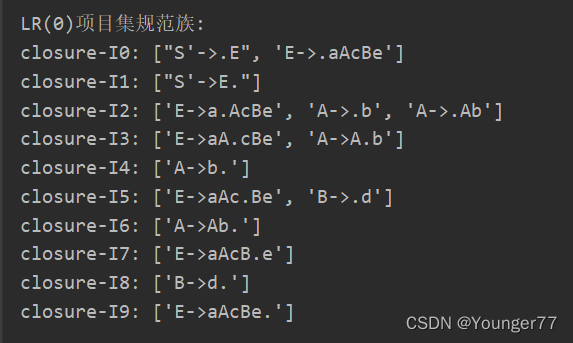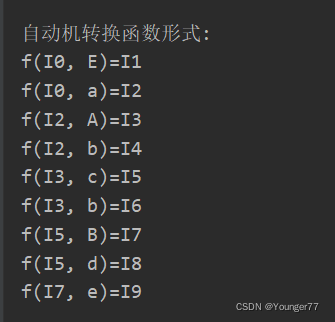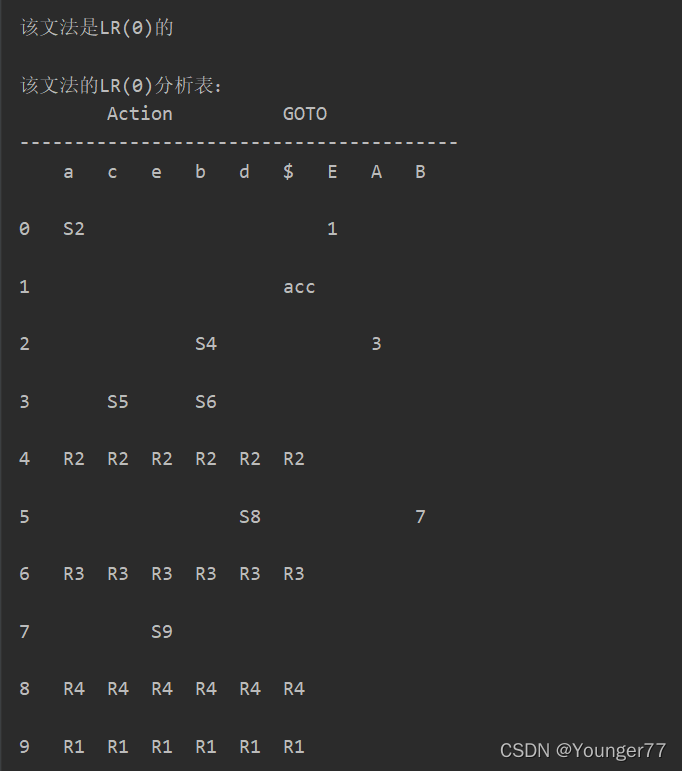目录
一、实验要求:
- 给定LR(0)文法,计算LR(0)项目集规范族。
- 构造其自动机(转换函数形式)。
- 判断文法是否为LR(0)的。
- 根据自动机构造其语法分析表。
- 模拟LR语法分析过程。
二、实现效果:(基于python实现)

?



 ?
?
三、源代码 :
grams = [] # 存储产生式
dot_grams = [] # 存储带.的产生式
VN = [] # 非终结符集
VT = [] # 终结符集
V = [] # 终结符和非终结符集
items = [] # 存储LR0项目集规范族
fx = [] # 存放自动机转换函数
table = [] # 存放LR(0)分析表
analyse_fx = [] # 存放输出串分析过程中所使用的产生式
def get_grams():
with open("1.txt", "r") as f:
for line in f:
line = line.replace('\n', "")
grams.append(line)
f.close()
def print_grams():
print("输入文法:")
for gram in grams:
print(gram)
# 划分终结符和非终结符
def get_v():
for s in grams:
x, y = s.split("->")
# print(x,y) x:'S' y:'aAcBE'
if x not in VN:
VN.append(x)
for v in y:
if v.isupper():
if v not in VN:
VN.append(v)
else:
if v not in VT:
VT.append(v)
# 终结符加上$
VT.append("$")
# 求终结符和非终结符集
V.extend(VN)
V.extend(VT)
# for vn in VN:
# V.append(vn)
# for vt in VT:
# V.append(vt)
# 为所有产生式加点
def dot_gram():
# 增广文法
str0 = "S'->." + grams[0][0]
dot_grams.append(str0)
str1 = "S'->" + grams[0][0] + "."
dot_grams.append(str1)
for gram in grams:
# ind = gram.find("->")
for i in range(len(gram) - 2):
tmp = gram[:3 + i] + "." + gram[3 + i:]
dot_grams.append(tmp)
# 返回非终结符产生的A->.aBb形式
def get_VN_gram(v):
res = []
for gram in dot_grams:
index = gram.find("->") # 返回'-'的下标
if gram[0] == v and gram[index + 2] == ".":
res.append(gram)
return res
# CLOSURE函数
def Closure(I):
closure = I
for it in I:
if it not in closure:
closure.append(it)
x, y = it.split(".")
if y == "": # .后面为终结符无操作,跳转到下一次循环
continue
v = y[0]
if v in VN: # .后面为非终结符,加入B->.γ
res = get_VN_gram(v)
for re in res:
if re not in closure:
closure.append(re)
return closure
# Go函数
def Go(I, v):
# 生成并返回下一个item
tmp = []
for it in I:
x, y = it.split(".")
if y != "":
if y[0] == v:
new_it = x + y[0] + "." + y[1:]
tmp.append(new_it)
if len(tmp) != 0:
new_item = Closure(tmp)
return new_item
def is_inItems(new_item):
# 判断item是否已经存在, 存在返回位置,不存在返回-1
if new_item is None:
return -1
new_set = set(new_item)
num = 0
for item in items:
old_set = set(item)
if old_set == new_set:
return num
num = num + 1
return -1
# 添加DFA的转换函数
def myAppend(xx, v, xy):
t = []
t.append(xx)
t.append(v)
t.append(xy)
fx.append(t)
# 构建item的集合
def get_items():
# 初始化,生成I0
item = []
item.append(dot_grams[0])
it = Closure(item)
num = 0
# print("I0 is :" + str(item))
items.append(it)
num = num + 1
# print("\n自动机转换函数形式:")
for item in items:
for v in V:
new_item = Go(item, v)
# 判断状态不为空
if new_item is not None:
if is_inItems(new_item) == -1: # 不存在于状态集items中
items.append(new_item)
x = is_inItems(item)
y = is_inItems(new_item)
# print("f(I{0},{1})=I{2}".format(x, v, y))
myAppend(x, v, y)
num = num + 1
else: # 存在于状态集items中
x = is_inItems(item)
y = is_inItems(new_item)
# print("f(I{0},{1})=I{2}".format(x, v, y))
myAppend(x, v, y)
# 输出LR(0)项目集规范族
def print_items():
print("\nLR(0)项目集规范族:")
for i in range(len(items)):
print("closure-I{0}: {1}".format(i, items[i]))
# 输出DFA的转换函数形式
def print_fx():
print("\n自动机转换函数形式:")
for f in fx:
print("f(I{0}, {1})=I{2}".format(f[0], f[1], f[2]))
# 判断文法是否为LR(0)
def judge_isLR0():
for item in items:
# 对于项目集中的每一个项目
shiftNum = 0
protocolNum = 0
for it in item:
# dot_index = it.find(".")
# if dot_index + 1 >= len(it): # .在最后,item中找到一个规约项
# shiftNum = shiftNum + 1
# elif it[dot_index + 1] in VT: # .后面为终结符,item中找到一个移进项
# protocolNum = protocolNum + 1
x, y = it.split(".")
if y == "":
protocolNum = protocolNum + 1
elif y[0] in VT:
shiftNum = shiftNum + 1
if protocolNum > 1 or (protocolNum >= 1 and shiftNum >= 1):
print("\n该文法不是LR(0)的")
return -1
print("\n该文法是LR(0)的")
return 1
def is_ingrams(new_gram):
# 判断noDot_item是否已经存在, 存在返回位置,不存在返回-1
if new_gram is None:
return -1
for i in range(len(grams)):
if new_gram == grams[i]:
return i
return -1
# 创建LR(0)分析表
def creat_table():
tmp = []
tmp1 = []
index_tmp1 = 0
for item in items:
t = []
for it in item:
x, y = it.split(".")
if y == "":
if it == dot_grams[1]:
t.append("-1")
else:
t.append("0")
new_gram = x + y
tmp1.append(is_ingrams(new_gram))
else:
t.append(y[0])
tmp.append(t)
# print(tmp)
for index_temp in range(len(tmp)):
t = []
for v in VT:
# S'->E. 接受项目
if "-1" in tmp[index_temp]:
if v == "$":
t.append("acc")
else:
t.append("")
# .在最后,规约项目
elif "0" in tmp[index_temp]:
for vt in VT:
t.append("R" + str(tmp1[index_tmp1]+1))
index_tmp1 = index_tmp1 + 1
break
# .后面为终结符 移进项目
elif v in tmp[index_temp]:
for f in fx:
if f[0] == index_temp and f[1] == v:
t.append("S" + str(f[2]))
break
else:
t.append("")
# .后面为非终结符 待约项目
for v in VN:
if v in tmp[index_temp]:
for f in fx:
if f[0] == index_temp and f[1] == v:
t.append(str(f[2]))
break
else:
t.append("")
table.append(t)
# 打印LR(0)分析表
def print_table():
print("\n该文法的LR(0)分析表:")
print('\t\tAction', end='\t')
print('\t\tGOTO')
print('----------------------------------------')
print("", end="\t")
for v in VT:
print(v, end="\t")
for v in VN:
print(v, end="\t")
print("\n")
for i in range(len(items)):
print(i, end="\t")
for j in range(len(V)):
print(table[i][j], end="\t")
print("\n")
# 按格式输出字符串分析信息
def print_analyseinfo(status_stack, output_stack, input_stack, string):
s = "".join(status_stack)
o = "".join(output_stack)
reverse_input_stack = input_stack[::-1]
i = "".join(reverse_input_stack)
print('%-20s' % s, end='')
print('%-20s' % o, end='')
print('%20s' % i, end='')
if string == "":
print('%20s' % 'wrong')
else:
print('%20s' % string)
# LR(0)分析过程
def analyse():
status_stack = ['0']
input_stack = ['$']
output_stack = ['$']
v = []
v.extend(VT)
v.extend(VN)
string = input("请输入要分析的字符串:")
print("对输入串{0}的分析过程:".format(string))
for s in string[::-1]: # 逆序
if s in VT:
input_stack.append(s)
else:
print("字符串含有其它终结符,不是该文法的句子!")
return
print('%-20s' % 'Status', end='')
print('%-20s' % 'Symbol', end='')
print('%20s' % 'Input', end='')
print('%20s' % 'Action/Goto')
for i in range(80):
print("-", end="")
print()
while True:
s1 = status_stack[-1] # 状态栈栈顶元素
s2 = input_stack[-1] # 输入栈栈顶元素
index1 = int(s1) # 第几个项目集
index2 = v.index(s2) # s2在V中的位置
string = table[index1][index2] # 获得对应的table表中的信息
print_analyseinfo(status_stack, output_stack, input_stack, string) # 输出当前各个栈的状况
if string == "":
print("输入串不是该文法的句子!")
break
elif string[0] == "S": # Action[s,a]
status_stack.append(string[1])
input_stack.pop()
output_stack.append(s2)
elif string[0] == "R":
x, y = grams[int(string[1])-1].split("->")
status_stack = status_stack[:-len(y)] # 出栈
output_stack = output_stack[:-len(y)] # 出栈
input_stack.append(x) # 进栈
analyse_fx.append(grams[int(string[1])-1]) # 保存使用的产生式
elif string == "acc":
print("输入串是该文法的句子!")
print("使用的产生式依次为:")
for af in analyse_fx:
print(af)
break
else: # Goto[t,A]
status_stack.append(string)
input_stack.pop()
output_stack.append(s2)
if __name__ == '__main__':
get_grams()
print_grams()
get_v()
dot_gram()
get_items()
print_items()
print_fx()
if judge_isLR0() == 1:
creat_table()
print_table()
analyse()?四、测试文法(保存于1.txt)
?
?五、参考代码
?六、源代码下载
含有多个测试用例,和更多的注释?